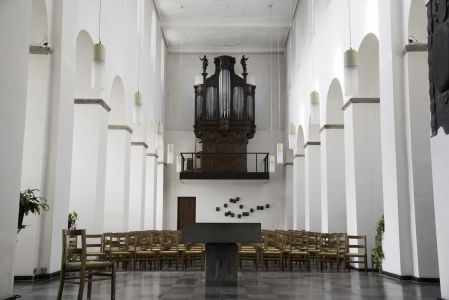Church | XI-XII | Romanesque | Catholic Church



Map
Opening hours
01 January - 31 December
Mon 9.00 - 18.00
Tue 9.00 - 18.00
Wed 9.00 - 18.00
Thu 9.00 - 18.00
Fri 9.00 - 18.00
Sat 9.00 - 18.00
Sun 9.00 - 18.00
Religious offices
Description
The large 11th century tower was originally used as a refuge for the noble family (the Wierde’s) and the surrounding populations in case of danger. Access was through a high opening on the south side (now blocked). It is estimated that in ancient times the tower was covered with a "hourd", a kind of wooden covered platform overlooking the walls, from which various projectiles could be thrown at the attackers. Currently, several loopholes can still be seen on its various sides.
The original church, built at the expense of the local lord and villagers, was made of wood and was probably reduced to a single nave. Due to the increase in the population, the church had to be enlarged but the lord did not wish to contribute to the costs, so it was transferred to the abbey of Géronsart, located on the borders of Namur. It was replaced by a stone building with three naves, six bays and a flat-headed choir, once framed by two apsyoles.
A serious fire destroyed roofs and ceilings in 1706. The tower was restored ten years later, topped by an octagonal three-level slate spire and equipped with 3 new bells. The lower square room was then used as a school, which probably explains the presence of a large open fire. There is a great Christ in polychrome wood decorated with the symbol of the 4 evangelists.
Later, sacrificing to the taste of the time, the interior furniture was redesigned in baroque style.
Major restoration work was undertaken in the late 1970s by architects Roger Bastin and M. Genot, assisted by sculptor Jean Williame and master glassmaker Louis-Marie Londot. They favoured a return to Romanesque semi-circular arches and a deliberately bare decoration.
In addition to pretty confessionals, there are four polychrome wooden statues of saints from the 17th and 18th centuries (Saint Donat, Saint Roch, Saint Fiacre and Saint Hubert) in the aisles.
KIKIRPA : Photo-library online
Photos
Remarkable elements
Medival tower from the 11th century
Predating the church, it was originally a defensive tower that served as a refuge for the noble family and the surrounding populations in case of danger. Isolated, it had only a defensive role and was probably covered at the beginning with a "hourd", a kind of removable wooden platform. From that distant era it still has some loopholes. Its only access was from the south side (side of the Cemetery) through a door located high up, which meant that it was only accessible by a ladder. Once removed, access to the tower became impossible. This access - still visible - was archered in the middle Ages.
Organ
The magnificent 17th century baroque buffet is the oldest in Namur. According to some sources it comes from the nearby abbey of Géronsart (Jambes). The archives of this abbey mention the intervention, in 1763, of the Barnabé factor, then in 1780 of Ditgen. Given the rarity of 17th century Walloon organs, the path of restoration is essential.
Way o f the cross
Under the rood pole, work by sculptor Jean Willame; a series of small polished granite blocks, which mark out a route that is both hesitant and precise - which runs as if along small narrow streets - from the place of the Last Supper (in the centre of the composition) to that of the Resurrection (on the far right). Unusually, it has 16 stations rather than 14 as usual.
The altar, the credence (opposite the sacristy door), the lintel of the front door - representing some scenes from rural life - are also the work of Jean Willame, as well as the baptismal font that stands out in its simplicity.
Polychrome stained glass windows
The stained glass windows are the work of Louis-Marie Londot: a small one above the entrance door of the tower, 3 large ones in the choir and a small one above the baptismal font (in the absidiole of the left side nave). In fine weather, the lateral stained glass windows of the choir project a wonderful palette of colors on the opposite wall, like a kaleidoscope, in the morning through the right stained glass window, and at the end of the day through the left stained glass window.
Pavement
Admirable of life with its old slabs with patinas reflecting the weight of the years. Although black, it makes a particularly bright reflection.
























